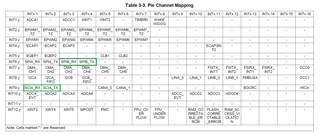Other Parts Discussed in Thread: AFE031
Hi
My project uses SCI A to RS485. Below is my code for configuration
code [1]
SCI_setConfig(SCIA_BASE, 25000000, ulBaudRate, (wlen |
stopbits |
parity));
SCI_resetChannels(SCIA_BASE);
SCI_clearInterruptStatus(SCIA_BASE, SCI_INT_TXRDY | SCI_INT_RXRDY_BRKDT);
SCI_enableModule(SCIA_BASE);
SCI_performSoftwareReset(SCIA_BASE);
SCI_enableInterrupt(SCIA_BASE, SCI_INT_TXRDY | SCI_INT_RXRDY_BRKDT);
SCI_clearInterruptStatus(SCIA_BASE, SCI_INT_TXRDY | SCI_INT_RXRDY_BRKDT);
Interrupt_enable(INT_SCIA_RX);
Interrupt_enable(INT_SCIA_TX);
The setup works very well and then I add SPI module B to control TI AFE031 code [2]
Add SPI Module for communication between the IC and MCU. Below is code to configure SPI B
code [2]
GPIO_SetupPinMux(16, GPIO_MUX_CPU1, 0);
GPIO_SetupPinOptions(16, GPIO_OUTPUT, GPIO_PUSHPULL)
GPIO_WritePin(16, 0);
SpibRegs.SPIFFTX.all = HAL_SPI_FFTX;
SpibRegs.SPIFFRX.all = HAL_SPI_FFRX;
SpibRegs.SPIFFCT.all = 0x0;
EALLOW;
ClkCfgRegs.LOSPCP.all = HAL_SPI_LSPCLK;
EDIS;
SpibRegs.SPICCR.bit.SPISWRESET = 0;
SpibRegs.SPICCR.bit.CLKPOLARITY = 1;
SpibRegs.SPICCR.bit.SPILBK = 0;
SpibRegs.SPICCR.bit.SPICHAR = 15; //16-bit character
SpibRegs.SPICCR.bit.HS_MODE = 0x1;
SpibRegs.SPICTL.bit.SPIINTENA = 0; // Interrupt disable
SpibRegs.SPICTL.bit.TALK = 1; // Transmit enable
SpibRegs.SPICTL.bit.MASTER_SLAVE = 1; //Master
SpibRegs.SPICTL.bit.CLK_PHASE = 0; //Normal phase, depending on SPICCR.6 (CLOCK_POLARITY)
SpibRegs.SPICTL.bit.OVERRUNINTENA = 0; //Overrun interrupt disable
SpibRegs.SPIBRR.bit.SPI_BIT_RATE = HAL_SPI_BRR;
SpibRegs.SPIPRI.bit.FREE = 1; // Set so breakpoints don't disturb xmission
SpibRegs.SPICCR.bit.SPISWRESET = 1; // Ready to transmit
UART Module A (SCI) doesn't aftere code [2] executed. If Code [2] doesn't executed, UART function recovered.
I am using SCI A for UART and SPI B separately for different function. I supposed they should not be affected each other.
Any idea?


